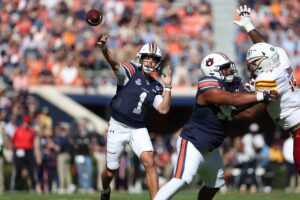At first mention, ”Air Raid” doesn’t sound like an offense built around running backs. The name itself draws comparisons to the ”Air Coryell” offense of the 1980s when Dan Fouts constantly aired it out to his San Diego Chargers receivers. The ”Run and Shoot” and ”Fun and Gun” offenses come to mind as well; however, North Carolina’s new offensive system is quite different. Offensive coordinator Phil Longo will utilize a deep and talented trio of running backs early and often this season. Now, we look at how the North Carolina running backs can thrive in Air Raid offense.
North Carolina Running Backs Can Thrive in Air Raid Offense
At no position on the field are the Tar Heels deeper or more experienced than at running back. While the team lost Jordon Brown to transfer, the cupboard is stockpiled, with Michael Carter, Antonio Williams, and Javonte Williams all returning from last season. All three will figure prominently into the Heels’ offense, probably more than at any previous point in their careers.
Carter was recently named to the Doak Walker Award watchlist; the award is given to the top running back in the nation. His season got off to a late start last year, as he broke his hand in training camp and missed the first two games. After his return, he performed well, with 165 yards on 18 carries against Virginia Tech and 148 yards and a touchdown against Duke in early November. Carter came to North Carolina as a highly-touted recruit, and when he’s been healthy, he has lived up to the big expectations.
Williams was a blue-chip recruit himself; he was touted as the seventh-ranked high school running back in the country when he committed to Ohio State. However, the Buckeyes’ running back room was already loaded when Williams arrived, and he struggled to find playing time before transferring from Columbus to Chapel Hill. Williams is the bruiser of the group, with an ability to power his way through contact.
Williams Impressed Late in the Season
Since the end of last year, Williams has received perhaps the most hype of any of the running backs. As a freshman, Williams didn’t play much before the final two games of last season. Once his number was called, he was simply brilliant. Against Western Carolina, Williams carried the ball 17 times, for 93 yards and three touchdowns. He followed that up with a touchdown and 83 yards on 16 carries against NC State.
Williams played his high school ball at Wallace-Rose Hill, one of North Carolina’s top football programs. However, he somehow flew under the recruiting radar. Williams considered quitting football before the Tar Heels came calling but now finds himself in a position to be one of the better running backs in the ACC.
The group as a whole accounted for 1,448 yards on 256 carries last season, for an impressive 5.7 yards average. Head coach Mack Brown recently stated that the running backs are unquestionably the strongest unit on the team.
An Expanded Role in the Offense
In the new Air Raid system, the running backs will see their workload expanded. All three will be used increasingly as pass-catchers out of the backfield. Carter estimated that in practice, around 60% of the running backs’ touches were run plays, while the other 40% were passing plays.
The Heels’ will have a new quarterback under center, along with a relatively young group of receivers. While the Heels will undoubtedly look to take some shots downfield, the running backs will almost certainly see their receiving yards increase this year. Carter might be relied on the most as a backfield pass-catcher. He has good hands and the speed to take it to the house if he gets any separation.
Of course, the success of the running backs will depend on the performance of the offensive line, which is also young but does include two seniors. Senior Charlie Heck will move from right tackle to left tackle and will be counted on to anchor the group. At this summer’s ACC Kickoff Conference, Heck spoke of the importance of the running backs to the Air Raid offense. ”With the Air Raid offense, for that to be successful, you need to be able to run the ball. We’ve got three running backs that are special. It’s exciting to be an offensive lineman blocking for them.”
The Other Skill Positions will Benefit
As we continue looking at how the North Carolina running backs can thrive in Air Raid offense, we look at the impact to other positions. While there is no certainty yet as to who the starter will be at quarterback, the options include two redshirt freshmen, Jace Ruder, and Cade Fortin, and true freshman Sam Howell. The veteran running back group will help in the development of the new quarterback. Having the ability to move the ball on the ground or catch passes out of the backfield, the running backs will lessen the pressure on a young quarterback to sling it downfield.
The effectiveness of the running backs will benefit the receiving corps as well. If defenses have to respect the Tar Heels’ ground game, the young receivers, led by junior Dazz Newsome and sophomore Dyami Brown, will find more separation and chances to make game-changing plays.
This is the deepest and most talented group of running backs since 2015, when Elijah Hood, T.J. Logan, and Romar Morris occupied the UNC backfield. That team went 11-3 and played for the ACC Championship. This season’s success will hinge upon the running backs as well. The new offense could be just what the doctor ordered for utilizing the strength of Carolina’s current running back group. This is a talented troika that could spell trouble for opposing defenses.






